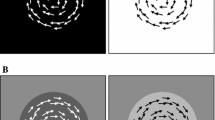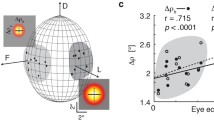Summary
-
1.
Spectral-sensitivity functions of large-field movement-detecting units in the lobula plate of the dronefly Eristalis tenax L., which is a Batesian mimic of the honeybee, were measured using visual stimuli consisting of light flashes, or moving gratings. Two classes of units were studied, one class responding to inward horizontal motion in the contralateral eye (presumably the homologue of the well-known ‘HI’ in other fly species), and the other class responding to vertically-down-ward motion in the contralateral eye.
-
2.
In both classes of units, the spectral-sensitivity function of the response to ‘flashes’ is characterized by two peaks, one in the UV at ca. 350 nm and the other in the blue at ca. 475 nm (Figs. 3, 8). It resembles the spectral-sensitivity function of the R1-R6 class of receptors in other flies.
-
3.
In both classes of units, the spectral-sensitivity function of the response to ‘movement’ is characterized by a single peak, occurring in the blue at ca. 450 nm (Figs. 7, 9).
-
4.
Control experiments on homologous units in the Australian Sheep Blowfly Lucilia cuprina, using identical stimulating conditions reveal that the response to flashes as well as movement possesses a dual-peaked spectral sensitivity, with one peak in the UV and the other in the blue-green region of the spectrum (Figs. 10–12).
-
5.
The results indicate that the pathways subserving the inputs to movement-detecting neurons in Eristalis are driven by more than one spectral class of photoreceptors. They also reveal that the spectral sensitivity of movement detection in Eristalis bears a closer resemblance to that of the honeybee, than to that of other flies. This similarity to the honeybee may arise from the fact that the dronefly and the honeybee occupy similar ecological niches, both foraging for nectar in flowers.
Similar content being viewed by others
References
Bishop LG (1974) An ultraviolet receptor in a dipteran compound eye. J Comp Physiol 91:267–275
Bishop LG, Keehn DG (1967) Neural correlates of the optomotor response in the fly. Kybernetik 3:288–295
Buchner E (1984) Behavioural analysis of spatial vision in insects. In: Ali M (ed) Photoreception and vision in invertebrates. Plenum Press, New York, pp 561–621
Datum K-H, Weiler R, Zettler F (1986) Immunocytochemical demonstration of Gamma-amino butyric acid and glutamic acid decarboxylase in R7 photoreceptors and C2 centrifugal fibres in the blowfly visual system. J Comp Physiol A 159:241–249
Dvorak DR, Bishop LG, Eckert HE (1975) On the identification of movement detectors in the fly optic lobe. J Comp Physiol 100:5–23
Dvorak DR, Srinivasan MV, French AS (1980) The contrast sensitivity of fly movement-detecting neurons. Vision Res 20:397–407
Eckert H (1971) Spektrale Empfindlichkeit des Komplexauges von Musca. Kybernetik 14:1–23
Eckert H, Hamdorf K (1981) The contrast frequency-dependence: A criterion for judging the non-participation of neurons in the control of behavioural responses. J Comp Physiol 145:241–247
Hardie RC (1979) Electrophysiological analysis of fly retina. I: Comparative properties of R1–6 and R7 and 8. J Comp Physiol 129:19–33
Hardie RC (1985) Functional organization of the fly retina. In: Ottoson D (ed) Progress in sensory physiology vol 5. Springer, Berlin Heidelberg New York, pp 1–79
Hausen K (1976) Functional characterization and anatomical identification of motion sensitive neurons in the lobula plate of the blowfly Calliphora erythrocephala. Z Naturforsch 31c:628–633
Heisenberg M, Buchner E (1977) The role of retinula cell types in visual behaviour of Drosophila melanogaster. J Comp Physiol 117:127–162
Horridge GA, Mimura K, Tsukahara Y (1975) Fly photoreceptors. II. Spectral and polarized light sensitivity in the drone fly Eristalis. Proc R Soc Lond B 190:225–237
Ilse D (1949) Colour discrimination in the drone fly Eristalis tenax. Nature 163:255–256
Kaiser W (1975) The relationship between visual movement detection and colour vision in insects. In: Horridge GA (ed) The compound eye and vision of insects. Clarendon Press, Oxford, pp 359–377
Kirschfeld K, Lutz B (1974) Lateral inhibition in the compound eye of the fly, Musca. Z Naturforsch 29c:95–97
Menzel R (1973) Spectral response of moving detecting and ‘sustaining’ fibres in the optic lobe of the bee. J Comp Physiol 82:135–150
Menzel R (1979) Spectral sensitivity and colour vision in invertebrates. In: Autrum H (ed) Vision in invertebrates. (Handbook of sensory physiology, vol VII/6A). Springer, Berlin Heidelberg New York, pp 503–580
Maddess T, Laughlin SB (1985) Adaptation of the motion-sensitive neuron H1 is generated locally and governed by contrast frequency. Proc R Soc Lond B 225:251–275
Matic T (1983) Electrical inhibition in the retina of the butterfly Papilio. I. Four spectral types of photoreceptors. J Comp Physiol 152:169–182
Matic T, Laughlin SB (1981) Changes in the intensity-response function of an insect's photoreceptor due to light adaptation. J Comp Physiol 145:169–177
McCann GD, Arnett DW (1972) Spectral and polarization sensitivity of the dipteran visual system. J Gen Physiol 59:534–558
Nässel DR, Holmqvist MH, Hardie RC, Hakanson R, Sundler F (1988) Histamine-like immunoreactivity in photoreceptors of the compound eyes and ocelli of the flies Calliphora erythrocephala and Musca domestica. Cell Tissue Res 253:639–646
Stavenga DG (1979) Pseudopupils of compound eyes. In: Autrum H (ed) Comparative physiology and evolution of vision in invertebrates. (Handbook of sensory physiology, vol 7/6A) Springer, Berlin Heidelberg New York, pp 357–439
Tinbergen J, Abeln RG (1983) Spectral sensitivity of the landing blowfly. J Comp Physiol 150:319–328
Tsukahara Y, Horridge GA (1977) Interaction between two retinula cell types in the anterior eye of the dronefly Eristalis. J Comp Physiol 115:287–298
Vogt K, Kirschfeld K, Stavenga DG (1982) Spectral effects of the pupil in fly photoreceptors. J Comp Physiol 146:145–152
Wehner R (1981) Spatial vision in arthropods. In: Autrum H (ed) Comparative physiology and evolution of vision in invertebrates. (Handbook of sensory physiology, vol VII/6C) Springer, Berlin Heidelberg New York, pp 287–616
Wyszecki G, Stiles WS (1967) Color science. John Wiley, New York p 584
Author information
Authors and Affiliations
Rights and permissions
About this article
Cite this article
Srinivasan, M.V., Guy, R.G. Spectral properties of movement perception in the dronefly Eristalis . J Comp Physiol A 166, 287–295 (1990). https://doi.org/10.1007/BF00204803
Accepted:
Issue Date:
DOI: https://doi.org/10.1007/BF00204803




